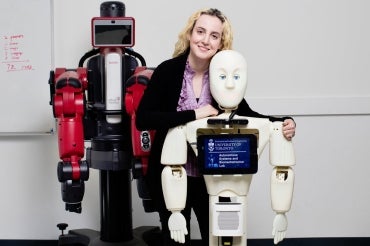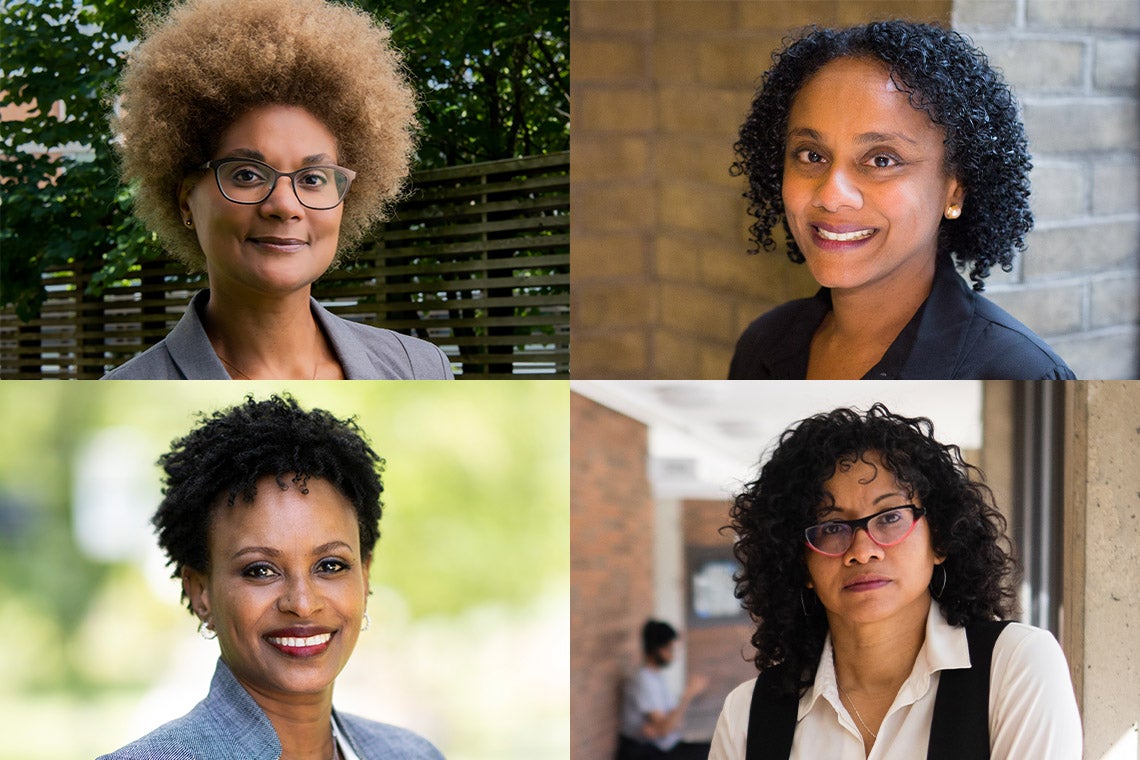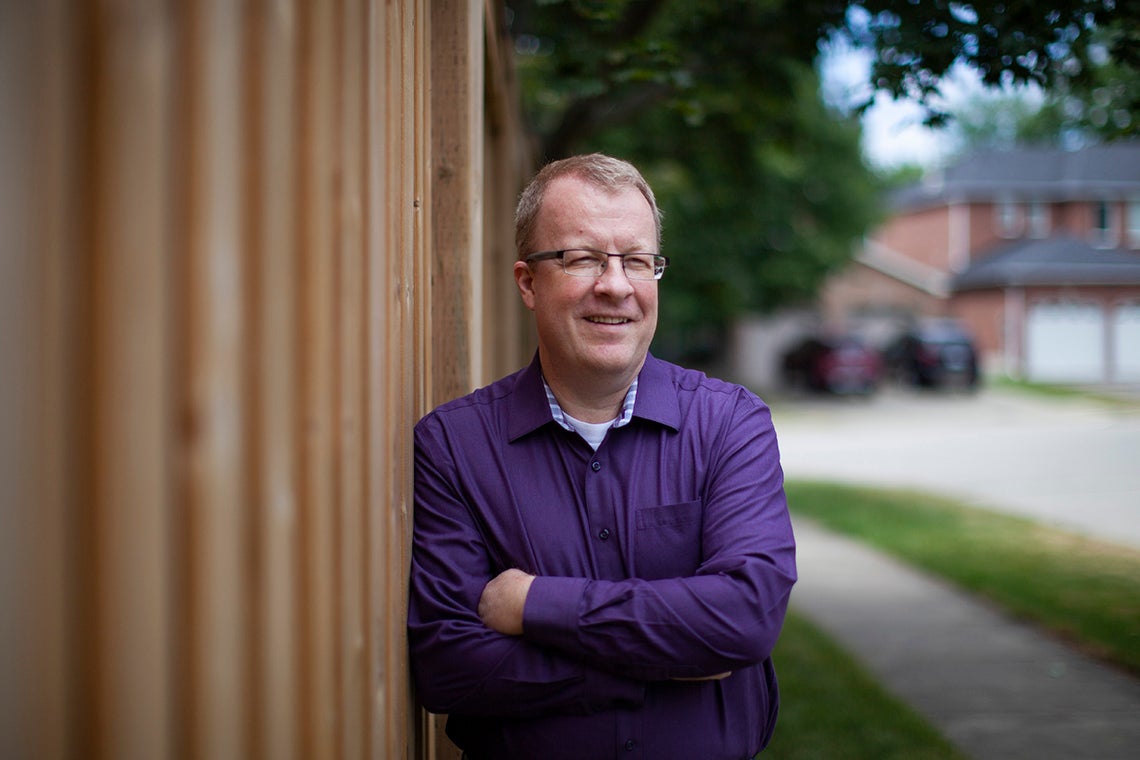Groundbreakers: U of T initiative brings together experts to address major societal issues

Published: September 2, 2021
Goldie Nejat envisions a world where growing old is improved by robots that care.
The Canada Research Chair in Robots for Society and professor of mechanical engineering in the University of Toronto’s Faculty of Applied Science & Engineering is an expert in assistive robotics – machines that provide care, interventions and even companionship for long-term care residents and people living with dementia and other cognitive and physical impairments.
The work is extraordinarily complex. In addition to engineering and artificial intelligence, creating robotic companions for an aging population often requires expertise in gerontology, cognitive neuroscience and medicine – even ethics.
Enter the Robotics Institute. Part of U of T’s Institutional Strategic Initiatives (ISI) program, the institute brings together top experts in different fields – from hardware design to public policy – to solve thorny, robotics-related problems in applications ranging from health care and transportation to manufacturing and logistics.
“Being at U of T, you have access to world-class researchers,” says Nejat. “Every time I want to find a collaborator with specific expertise and knowledge, it's really easy.
“A lot of us [robotics engineers] work with surgeons, doctors, physiotherapists, occupational therapists – you name it.”
The Robotics Institute is just one of nearly two dozen institutional strategic initiatives launched by U of T to address complex, real-world challenges that cut across fields of expertise. Each initiative brings together a flexible, multidisciplinary team of researchers, students and partners from industry, government and the community to take on a “grand challenge.”
“The goal is to bring scientists, researchers and the broader research community together to achieve something that no one scientist or scientists from a single discipline could achieve on their own,” says Christine Allen, U of T’s associate vice-president and vice-provost, strategic initiatives.
“Whether they’re designing a new cancer treatment, developing more sustainable building materials, identifying better education systems for students with mental health issues, ISI participants are always exploring who can contribute – and who can benefit.
“Cross-divisional research and collaboration is paramount to addressing complex questions and making an urgently needed transformational impact.”

“A lot of us [robotics engineers] work with surgeons, doctors, physiotherapists, occupational therapists – you name it,” Nejat says (photo by University of Toronto)
The approach marks a departure from the traditional university model of loosely affiliated, but independent – and relatively siloed – faculties, departments, institutes and colleges. The problem, Allen says, is that modern societal challenges don’t map very well onto traditional university structures. Climate change, mental health, systemic racism, artificial intelligence and many other issues are so multifaceted and interconnected that they can only be addressed with diverse expertise, insights, and approaches.
The ISI approach, by contrast, seeks to take advantage of U of T’s size and breadth of expertise by creating research networks that cut across campuses and disciplines as varied as sociology and computer science – all in an effort to unlock answers to challenging problems and create new knowledge.
The Black Research Network, for instance, uses ISI’s multidisciplinary approach to help redress the sense of isolation that many Black faculty members feel by connecting them not only to each other, but also to the broader community – and resources – at the university.
“My work is to make sure the right conversations are happening, that the right clusters are coming together to produce small and large-scale research grants and teams,” says Beth Coleman, an associate professor of data and cities at U of T Mississauga’s Institute of Communication, Culture, Information and Technology and the Faculty of Information, and the network’s director. “In STEM fields especially, the number of Black professors is small and people tend to be really isolated.
“That isolation is part of why people succeed or don’t succeed. Some of that has to do with how comfortable you feel and how invited you feel.”
The co-founders of the network come from across the university: Rhonda McEwen, dean of U of T Mississauga; Maydianne Andrade, a professor of evolutionary biology and U of T Scarborough’s vice-dean of faculty affairs, equity and success; Lisa Robinson, associate dean, inclusion and diversity in the Temerty Faculty of Medicine, and Alissa Trotz, director of the Women & Gender Studies Institute.

The co-founders of the Black Research Network are (clockwise from top left): Professors Maydianne Andrade, Lisa Robinson, Alissa Trotz and Rhonda McEwen (photos by Dylan Toombs, Temerty Faculty of Medicine, Geoffrey Vendeville and Nick Iwanyshyn)
“You have four incredibly fierce and important Black women researchers moving us towards a thriving research culture,” says Coleman. “With their leadership, and with the university endorsing the Black Research Network as a strategic initiative, it makes it about more than addressing inequality and anti-Black racism – it’s also about shining a light on excellence through a directed, applied and resourced program.”
While the Black Lives Matter movement has recently put racism at the top of the daily news, the broad scope of the ISI initiative helps ensure that the Black Research Network can continue to make systemic change long after the news cycle has moved on.
The same goes for the work of the Emerging and Pandemic Infections Consortium, another ISI project.
“We don't want everyone to look away from infectious disease once the current pandemic recedes,” says Scott Gray-Owen, a professor of molecular genetics in the Temerty Faculty of Medicine who is director of the consortium. “There will be other pandemics, as well as more localized epidemics around the world. Toronto is a hub for transport and travel and is home to such an international community of people.
“Not only does that mean we’re likely to be affected, but we’re also a natural place to prepare to respond better next time.”

Scott Gray-Owen, a professor of molecular genetics in the Temerty Faculty of Medicine, is the director of the Emerging and Pandemic Infections Consortium (photo by Nick Iwanyshyn)
The consortium fosters innovative approaches to combatting infections through microbial biology, immunity and disease progression alongside the politics, economics and social impact of pandemic preparedness, prevention and mitigation.
“You’re trying to move society to a place where it actually prepares for something in advance,” Gray-Owen says. “And that is a very different type of challenge from just understanding microbial mechanisms.”
U of T has already created almost two dozen ISI projects, with more on the way. Each has its own structure and composition, but all take an evolved, advanced approach to mixing disciplines.
“Interdisciplinarity used to mean people would look at the same problem from different directions. That’s important and powerful, but we’re trying to deepen that integration. We’re all coming together to see how we can contribute to solving a problem,” Gray-Owen says. “We have experts around the table who are internationally renowned for their contribution to cancer or autoimmune diseases or surface decontamination. “The egos just go away, and new ideas come from that conversation.”
ISI projects also look beyond senior faculty and established scholars to engage students, government funders and policy-makers, commercial enterprises, not-for-profits, Indigenous groups, activists, citizen scientists, the media and the general public. The ISI networks typically also include training, mentoring and public education, which increases the impact of the research.
The programs aim to not only attract talent, but also grow it. Nejat, for one, says the openness of the ISI approach not only makes the research better, but it also helps ensure that the ideas that emerge have a positive impact in broader society.
“We've been very lucky to have a lot of interest in robotics from people who have never, ever dealt with the technology – people who come up with new research programs [related to robotics] that focus on the potential impact on society from a sociological or psychological point of view.
“It's really interesting to see them helping us pave that way into the future.”
This is the first article in a series about U of T’s Institutional Strategic Initiatives program – which seeks to make life-changing advancements in everything from infectious diseases to social justice – and the research community that’s driving it.



